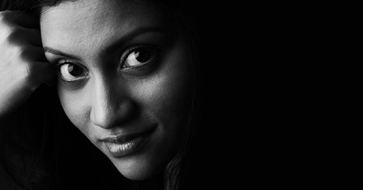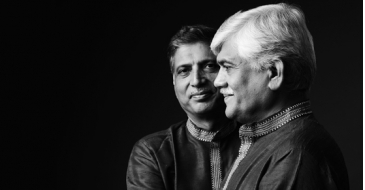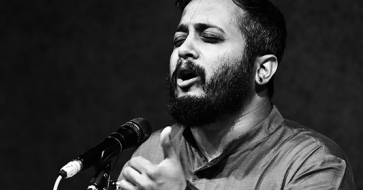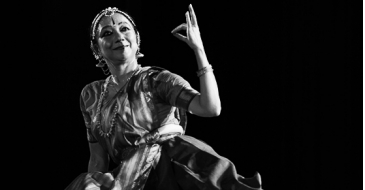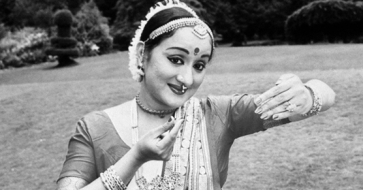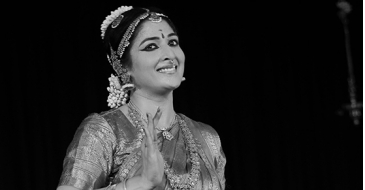You are gearing up for your next solo, The Battle Within this weekend. I am curious about the title and what really sparked off the idea of this creation?
When I think of the Bhagavad Gita, memories of my mother come back to me. In the last few years of her life, I would always see her sitting with this book in her hand; she constantly read it, read from it, and by virtue of that, there were verses that I was constantly hearing. Honestly, the Bhagavad Gita isn't the kind of book that I ever thought I'd be attracted to as it is philosophy dense. However, two years ago, the possibility of working on it came up as a project proposal from Dr B N Goswamy, who was giving a lecture on miniature paintings.
My research started on the Gita as I looked into creating a short exposition. That impulse also coincided with a time I heard a lecture by Ravi Ravindra, an amazing scholar, philosopher and writer of many books on philosophy and religion. In?uenced by that talk, I read his book, The Bhagavad Gita: A Guide to Navigating the Battle of Life, and I was completely blown away by how he made high and deep philosophy unbelievably accessible, allowing me to almost enter into its world.
The more and more I read his book, I realised I was being drawn and almost pulled into it. And I knew I was foraying into a new, unfamiliar territory. Somehow, that entire experience was subliminal; I just couldn't stay away from it.
After I presented it in a short version, I knew I needed to evolve it into a full-length production. And so began my deeper engagement with the Gita. When the choreography was almost complete, I reached out to Sumantra Ghosal with whom I had earlier collaborated on the production, Thari – The Loom. I admire his thought process, which is quite different from mine and yet so inspiring and energising. As I already had the concept and the choreography worked out, he added to it a visual layer, which is both stylised and minimalist, enhancing the dance, which incidentally I refer to as a dramatic interpretation in this case. By virtue of that layer, there is a constant conversation - of sorts - between the interpretation and the image, allowing one to play off the other.
You just spoke about how with this production you are stepping into a terrain that you are unfamiliar with. Can you elaborate a little on that?
When I say territory, I am referring to the emotional spaces of say sringaram, Sangam, bhakti poetry, all of which I have interpreted in the past; a field I have traversed over the decades. Whereas, with The Battle Within, we are talking about high philosophy, two male characters and a battlefield. Arjuna's crisis is a battle within a battle. That's where the title comes from. Arjuna's existential crisis, which is, in a sense, our collective crisis.
Along the journey of creating and choreographing The Battle Within, I ended up touching nerve endings of emotions I hadn't ever touched before. That is why I call this production a dramatic interpretation as it penetrates emotions to the core. The habituated pattern of jathis and swarams don't fit into this, unless of course it is part of the sound design to suggest an emotion. There is also no space as such for pure nritta passages. For instance, I would never take the Bhagavad Gita and put it in the varnam format!
There are some things in life that are planned and some that aren't. Creating The Battle Within could not have been deliberately planned. It was a calling
So how did you imagine and create it?
When I read it in translation, I just had to go with the narrative; the narrative of army lines drawn on either side, the chariot of Arjuna riding forth in the middle of the battle ?eld, of Arjuna saying, ‘Stop' for I see my kith and kin, ‘I cannot kill them' and the philosophy unfolding, thereafter.
When I began to attempt to experience this scenario in my mind, I realised the gravity of the discourse between the two characters. There is nothing more. As a result, it is very intense; it is not figurative, it is not descriptive; there's no distraction of any sort. All there is, is a tight and a deep discourse between two people.
As I began creating it, I realised how it seriously affected and impacted me. Even now, after several hours of rehearsals, every time I go through the lyrics, I almost feel like I am falling and falling into a deep, endless abyss, only to be lifted out by divine intervention.
I have been choreographing for the last three decades but no work has ever taken me to the emotional heights and ravines as the Gita has done. It is a feeling, an intensity, where you go down so deep that you are in a sense almost finished, shattered and just when nothing is left, you see the Vishwaroopam. And when that happens, it is like you've found a new lease of life, a new possibility of return, of rejuvenation, of resurgence. What's more amazing is that as you are going through this feeling, the philosophy is also permeating oneself and through the moment of Vismaya, of the Vishwaroopam, you actually find hope and you re-emerge.
This intensity is a first for me; it's different, it's kind of terrifying; it's like you are actually touching yourself, you feel a sense of raw emotions. There's nothing to clutch on to; it's like you are having to lay yourself bare, stripped off everything.
What's that feeling like; of being and becoming vulnerable in a sense?
It's like finding new life, new meaning. It's like even though you are being pulled deep in, you have the hope of being pulled out.
When we say Vishwaroopam, we often think of effulgence; of the glory of Vishnu, so intense and powerful. But here, in this case, Arjuna also sees Vishnu as the Terrible One; he sees the very dark side of the apocalypse, of the worlds disintegrating, into the jaws of this giant form.
When I was reading those passages, I said, ‘Oh My God, how will I interpret this? This kind of cosmic destruction, of all the worlds being sucked into the thousand mouths of this giant form with eyes so gory and bloody, a very dark and frightening image. I thought, and thought about it.... I didn't have a hasta (gesture) for this; I didn't have a reference point of sorts.
I knew I had to live the part. I had to inhabit this moment of truth. It's almost like a Black Hole. But how do I interpret a black hole? Finally, after much deliberation, I decided to let intuition have the better of me. I could not be held back by the need to conform. I had to be truthful to the context and the character. And so, I just let go and created what I thought was - for me - fierce, terrifying, terrible. I let the moment seize me and I created the intensity of that feeling. Confronting those raw emotions repeatedly isn't at all easy but I'm grateful for that experience.
Do you think The Battle Within also coincides with a certain phase in your life when you feel ready to be able to create work with this kind of intensity?
My mother's passing away turned the page for me in many ways. I think I was drawn more to philosophy as it helped me in my time of grief and loneliness. Her passing shattered me right down the middle. I had no strength in me for that part of me which was closest, had died. So I just crumbled... I did not dance for four months, which is the longest time I have gone without dancing.
Coming to terms with the loss of a loved one, has changed the way I dance. Today, I dance to experience something… I am really not interested in the performance of dance; I want to experience it. If I experience something, I know I touch something within myself. Right now, in the trajectory of my journey, I dance because I have something to say... because I want to live the dance and because it lets me journey to spaces I have never been to before.
You use the word inhabit, inhabiting Arjuna's character? How different is it from your previous work and inhabiting those characters?
I think it is about the emotions of Arjuna's character which are so raw, in comparison to other pieces that I have worked on earlier. In The Battle Within, it is really the crises of the human being and Arjuna is a prime example for that.
Speaking of the idea of inhabiting, I must say that I do that in every piece I create or perform. For instance, if one is doing a varnam, one has to inhabit the character of the nayika. But somehow, in The Battle Within, it is like hitting like rock bottom of those emotions.
I often think of those moments when my mother and I would sit together in the same room and just quietly read. It was a very special quality time we shared. On one of those occasions, I remember reading this one sentence that I've never been able to forget: “Arjuna's chariot of war transformed into his meditative cell.” I remember being completely struck by this line and sharing it with my mother because it was so compelling and affirmative that we, as people, have the ability to transform.
Inspired by that possibility of transformation, I have brought this motif into The Battle Within reinforcing the idea that there is after all hope in, and for, all of us. We do what we do, but if we hear our inner voice, it is possible to transform, even if momentarily.
Initially, you approach Arjuna and Krishna as two different characters. But as one investigates and delves deeper and deeper, one realises they are not separate anymore. When one sees this distance coming closer and actually merging, it is like a moment of vulnerable bliss. It is then, you acknowledge the deeper voice within you.
As the Mahabharata unfolds, one also knows that after the discourse in the Gita, the worst of atrocities are committed. The question is, why is the moment of truth so soon eclipsed? That is us, that is our condition. We might experience that moment of truth but to stay with it, we have to evolve. We experience it and then we lose it, and then we continue. It is a comment on humanity, on us as people. Even to see this moment of truth, Krishna gives him this divine sight. Earlier, Arjuna says to Krishna that the emotions tear through him like the turbulent wind and he is buffeted. To which Krishna says, ‘Look at me, I will give you divine sight'.
Arjuna, on receiving this sight, sees effulgence. One is graced to see divine sight, but also the tragedy that, after we see divine sight, we soon forget. The Gita becomes a text about us, and though I did not plan it in that way, The Battle Within centre stages Arjuna's grave dilemma. You see the despair of his condition and through that you see, our despair of our condition.
When you see it in him, we see it in us. We are just caught in the grip of these emotions and ahankara (ego). How does the ego which is pradhanam (centrestage), acknowledge the higher Self? Unless it becomes subdued, it cannot sense the other Self.
There are some things in life that are planned and some that aren't. Creating The Battle Within could not have been deliberately planned. It was a calling.

This intensity that I've felt while creating The Battle Within is a first for me; it's different, it's kind of terrifying; it's like you are actually touching yourself, you feel a sense of raw emotions. There's nothing to clutch on to; it's like you are having to lay yourself bare, stripped off everything
I am curious about this word interpretation. So, in a certain way Ravi Ravindra's book is his interpretation of the Gita. Is your work is an interpretation of his interpretation?
I have consciously stayed away from using the word dance because honestly there aren't any dance elements in this work. It is a dramatic interpretation within the language of Bharatanatyam. I am not interpreting Ravi Ravindra's take on the Gita. It is my interpretation. There is a lot of drama as the narrative demands. And the audience may not have seen me express myself in this language. But the emotions which are epic, of high intensity demanded this response from me. In The Battle Within it is a coming together of the worldly and the cosmic, the micro and the macro, the human and the divine.
When you are dealing with that kind of scale, you can't make it padartham (pedantic). How do I express it other than dramatic?
From a choreography point of view, how different was this compared to your other productions. The challenge of interpreting philosophy of something of this scale, nature and depth and translating it to a visual performance which does not adhere to traditional Bharatanatyam vocabulary?
I spent hours days and weeks reading and re-reading. It was a very silent process. I had to delve deep within myself to find the vocabulary. Usually, my music concepts are worked out in great detail and I have done so in this production as well. I give my musicians structure but importantly the freedom of manodharma (improvisation). Without this creative input, I am curtailed.
I would sit with myself and think about what works, almost like I am working in my laboratory. It is a very fine and delicate balance of putting together the music, the choreography and the way I want the concept to flow. Many hours went discussing the music concept with my singer, Murali Parthasarathy. The nuances of ragas, their moods, their specialities were delicately investigated. Slowly the music concept started to evolve over the months of crafting, and I could see a vision of the Bhagavad Gita emerge. I was keen to have a female and male voice represent the characters Arjuna and Krishna. Vasudha Ravi, was a natural choice for Arjuna as I have always admired her understanding of tradition and the freedom she finds within it. Aditya Prakash, another gifted singer, familiar with dance, did an amazing evocation of the philosophy of Krishna.
I am very particular about silences and the pauses. If there is some music that finishes at a certain point, sometimes I tell my musicians, to just give me a pause of a breath. It is critical that I have that one breath in between passages as it indicates a shift, a punctuation. It is fine detailing. I believe, excellence is in the details.
Collaborating with Sai Shravanam and recording in his studio is a professional’s delight. We understand the aesthetics of each other extremely well. And therefore, there are times when even words are unnecessary, and a glance will suffice. During track recording, I would go to the studio everyday when the musicians recorded individually. In a sense, this gave me a ring side view of every detail that went into the recording. Be it the alapana played on the instrument, the rendering of a text, the silences between notes , the complexity of the rhythmic passages….. Over the years, I’ve realised that is the only way I can achieve the kind of excellence I am seeking and wish to be inspired by.
The exceptional team of musicians who participated in the recording are S. Srilatha (Nattuvangam), Aditya Prakash & Vasudha Ravi (Vocals), Nellai A Balaji (Mridangam), Sai Shravanam (Tabla, Frame Drum & Keyboard) Bhavani Prasad (Veena) and JB Sruthi Sagar (Flute). They brought excellence, imagination, passion and conviction. It was moving to observe the highest of philosophies transform into melody and rhythm, sound and silence.
There are many layers to The Battle Within and the lighting design plays a significant role. Niranjan Gokhale brings to this production an inventiveness and ease as he lights the concept. He brings a sense of confidence to the exceedingly technical side of the production, for which I am so thankful! Working with a team who believe in excellence, is fulfilling as a creative process itself.
Sandhya Raman has been designing my costumes for several years now. It is wonderful to be able to discuss design, texture, aesthetics with a person who is committed to excellence in the details. At all stages of creating The Battle Within, I have sought out artists who are exceptional. And it has been rewarding.
After Thari - the Loom which was all about a group energy, what was it like to create The Battle Within, a very solo journey?
I think I needed this solo journey and what better than expressing the Bhagavad Gita! When I dance solo, I control the energies around me and energise the space, inner and outer. I can raise it to the intensity I dream of on that particular day. Whether it is my deeper experience of internalization, I can see now that my dance has shifted. I feel more freedom, I feel more at peace. I feel more manodharma. Dance has always taken me on a path, and I feel I am always going with it to places where I haven't been before and for that I am grateful. Deeply grateful.
You often speak of the body being your canvas. Has this production forced you to think about your relationship with your body?
Very much. I don't know if it is this production. But it is more this stage in my life. By the process of internalization of the Gita, it makes one realise the physicality of the body and the death of it. One also becomes increasingly aware of something deeper within the body, which is eternal. The question is – are you the body with an Atma or are you the Atma with a body? Needless to say, it is a profound question and requires much reflection.
I feel after so many years of dancing - of a certain abhyasa (study), tapasya (meditation) and sadhana (practice), after years of striving to achieve alignment of the body and the mind, one finally finds sruti (pitch) inside oneself and that is so important. This search to sustain sruti is a life-long quest and constant fine-tuning is imperative.
And now I can sense that if I can keep my body aligned, I sense another energy. The body after all is only a conduit. Honestly, no one asked me to traverse this inner path of alignment. I am so thankful to have heard my inner calling and responded to it with action.
When I dance solo, I control the energies around me and energise the space, inner and outer. I can raise it to the intensity I dream of on that particular day. Whether it is my deeper experience of internalization, I can see now that my dance has shifted. I feel more freedom, I feel more at peace. I feel more manodharma. Dance has always taken me on a path, and I feel I am always going with it to places where I haven't been before and for that I am grateful. Deeply grateful
You also often speak about dance being your creative expression...
I owe that approach to my mother. In all the years that we lived together, she'd keep saying, “Dance is a creative expression, your creative expression.” She never once told me to make it janaranjakam (public entertainment).
I am so thankful for that. Having said that, I must admit that it has been a very tough and lonely journey. What I am doing is not comfort zone. I have walked a different path by believing the language of Bharatanatyam must be extended. And I am so glad for that. But by virtue of travelling this path, I stand by my courage of conviction.
In the world we live in, people don't value the creative urge of an artiste. I have had to fight this all my life. When I look back at the trajectory of my own work, I have had to repeatedly say that dance is more than merely a pretty image, a form of entertainment. Unfortunately, today, we see dance as entertainment for the most part. It gives the audience passive viewing and delights the senses. It is perhaps one way of looking at it. But there's more than that to dance, surely is there not? The sad thing is we are gratified by applauding classical dance as entertainment. I don't know why we don't seek more ...Why we are so easily pleased.
I often think about why dancers don't train hard enough. Perhaps because training is hard. But just imagine what would happen if they trained diligently! You see so many dancers today who are so competent but are not driven. Why? Why are we settling for less? How can we live life so second-hand? Why don't we push the boundaries of ourselves to realise our potential?
What do we need for that to happen?
I'd say the starting point is technique. I have to mention a startling line on technique that has stayed with me, forever: “Technique disguises the dancer and reveals the dance.”
The question is why do we want to show ourselves? Why don't we just show the dance? For that to happen, we need technique. Why are we not pushing the dance? Do you have that answer?
I ask this again and again and come on, I am 60. I just turned 60!
Wow, how does that feel?
It feels fantastic; it's like finding a new sense of freedom.
You look back at your journey - you are almost to able to detach yourself from who you are and look at your journey as an outsider. Has The Battle Within in a sense forced you to do that?
Yes; it has certainly made me reflect.

And a personal reflection of sorts, no? Perhaps in your other work, you are inhabiting other characters but, in the Gita,, it becomes a more of a personal revelation, right?
Absolutely and that's because the Gita is also so distilled with emotions. To stay close to the bank of the river of emotions, I have not chosen the verses which are descriptive in nature except for a few.
The Battle Within is a personal interpretation as I am sure there have been and will be many more interpretations of the Bhagavad Gita. In this work, I confront despair but also confront bliss at the same time. When the moment of bliss is revealed, you feel washed over, as if you were cleansed. You feel so grateful to have experienced that bliss. And to think that the truth of bliss is actually within you!
Coming to terms with the loss of a loved one, has changed the way I dance. Today, I dance to experience something… I am really not interested in the performance of dance; I want to experience it. If I experience something, I know I touch something within myself. Right now, in the trajectory of my journey, I dance because I have something to say... because I want to live the dance and because it lets me journey to spaces I have never been to before
That sense of wonderment in your eyes, that quest, the seeking… How do you keep inspiring yourself?
I am really thankful that my heart responds to wonderment - to the champa tree outside. Every time I come back home from a trip, I caress my tree, as I would meet a friend. I am deeply thankful to all the poets who have written some amazing poetry; I think of the Alwars and the Nayanmars - of what they have written and what have they seen. It is only through their vision that I get a glimpse of the yearning of the beloved for the supreme. For allowing me this entry into their world, I am grateful. Grateful to classical dance.
Would you think that this dramatic interpretation and this foray into a world you have not entered before also means a certain shift in the way the audience perceives your dance?
Well if they do, it's fine! This is also a part of me. Think of a musician, they do kutcheris, then they do different kinds of collaborations and different kinds of music and that is all accepted. So why not a dancer? I will do a Thari, I will do ensemble work, I will do my own solo work, then this dramatic interpretation, because the text demands it. Why don’t we actually celebrate an artiste’s plural ways of artistic expression? Yes, I want my audience to see my different ways of expression. I am convinced, if I journey with honesty and authenticity, my audience will journey with me.
I have to frame expectations. I cannot expect the audience to frame expectations as they haven't seen far into dance as I have; by framing the artiste, it is killing artistic expression. Don’t frame me, I am a free spirit. I need to go where I need to go. Dance is pulling me in a certain direction, and I am going to follow that, because that is my inner calling. Everybody is invited, let’s all go together, but I lead the way because I have seen a path. And I am willing to take you that way. Come along with me, I will show you something you’ve never seen before.
As a serious dancer engaged with her art form for several decades, I have phases which mark my trajectory. But do you think anyone has seriously commented on this? I have been choreographing since 1986 and that is now several decades. Do you think anyone has bothered to critically analyse my body of work and examine my creative process? Other than the film, The Unseen Sequence directed by Sumantra Ghosal there has been little documentation on this aspect.
According to me, it is so important to document an artiste's contribution. Else, I suppose we have to write our own book. For example, thank goodness Veenapani Chawla wrote her book! I met her a few months before she passed away at Adishakti. She was generous in her welcome and invited me back. But before I could go there, it was too late. I had lost an opportunity to dialogue with an artiste of intensity. But for her book I would not have access into her world.
So, yes to answer your question, if my body sings like this now, it is the grace of god and my own tapasya. I want to dance for as long as I can, and I want to dance for many years. I want to be able to sing my dreams, dance my dreams... because why shouldn’t I? Why should I be defined by convention when I can dream? And really without dreams, how do you evolve?
I train my body with rigour so I can sing, and go as far as I want, as high as I want, and in whatever direction I please. I want to dream, and when I dream, I want my body, mind and being to see that dream. Dance for me, is flight. I don’t want to experience dance at eye level.
Most people forget to dream, people get so caught up in existence, that it is only people who dream beyond the rut of existence can create...
The creative part of my life is what I spend in the sanctity of my dance. Outside, there is the everyday grind of existence. It is tedious. There is hard work to be done, sitting in front of a computer, coordinating details, planning logistics. Between all this, one must have the desire to dream. Else, one can always say, ‘I am so busy, I cannot dream.'
If you cannot dream, it is like disallowing a part of yourself to exist. Of course, you play so many roles as mother, wife, daughter, but there is something which is our life spirit. It is precious. I am very grateful to have danced for so many years and that I have befriended dance. Dance and I now walk side-by-side as trusted companions.
Don't frame me, I am a free spirit. I need to go where I need to go. Dance is pulling me in a certain direction, and I am going to follow that, because that is my inner calling. Everybody is invited, let's all go together, but I lead the way because I have seen a path. And I am willing to take you that way. Come along with me, I will show you something you've never seen before
So many of us probably know a path but don't have the courage or the conviction to go...
Why? You have to go... Another beautiful quote I read, ‘Do we live with function or with purpose?' It is a big question.
Dance has given me all my life lessons and guided me towards purpose. Dance has helped me understand relationships, of space and time, nature, people and even the cyclicity of time. Dance has just opened up so many possibilities; it has helped me empathize and understand human emotions.
If you don't have empathy you can't be an artiste. When you have empathy you feel; when you feel, you relate, absorb and assimilate. It's a bit tricky, as sometimes you could get carried away; sometimes, the pain you feel is more intense.
But it is still a great teacher.
Also a sense of wonderment...
Oh! That is crucial. It is so much vaster than you. One day I was rehearsing The Battle Within when Sumantra was in Chennai. I was so drained even though I had danced for only 70 minutes. And I wondered why? Then I realised I was feeling drained by the sense of wonderment I had just experienced.
To be in the moment of Vismaya is very intense; and to remain in that moment is like being suspended in wonderment. Perhaps that emotion is most demanding, energising, but exhausting. Static but dynamic.
Is Kalavaahini, the Trust you founded, your attempt to encourage dancers to cultivate and sustain that sense of wonderment?
At Kalavaahini, we feel that technique is critical for excellence. We have the Fellowship Awards, Dance Immersion Program Workshop, and the Dance For Dance Festival which is about performance. I believe that along with that, we need hard core training to raise the bar. Because technique is hard to find. It requires unforgiving work on yourself. In Kalavaahini, we are pushing the idea of training in technique but not teaching items.
Technique gives you the freedom to go wherever you want to and be really communicative. The image that comes to my mind is like a horse galloping on meadows. It is disappointing when I don't find dancers thirsting for this edge to their craft.
I wonder if this happens in music...
To raise the bar, dancers need to align with sruti. Musicians luckily have the tambura, to align with. If we had an external reference point of sruti, many of the dancers won't be dancing. Because finding sruti is difficult and hard earned. Unless individual dancers raise their own bar, there cannot be a collective of dancers who say, ‘This is where the standard should be.'
Having less clutter in the dance scene, would provide more opportunities for the committed dancers and professionals. It would rejuvenate the dance scene and is screaming for attention. Organisers too, would see the difference in standard as also the audience.
I feel after so many years of dancing - of a certain abhyasa (study), tapasya (meditation) and sadhana (practice), after years of striving to achieve alignment of the body and the mind, one finally finds sruti (pitch) inside oneself and that is so important. This search to sustain sruti is a life-long quest and constant fine-tuning is imperative
That has been your singular pursuit... the importance of the pursuit of excellence?
Excellence is a state of mind. And in dance; it is for a larger purpose. To discover the unlimited qualities of dance. I am still discovering and this is what sustains my pursuit.
Can I find spirituality in pure dance? If I hit that alignment absolutely right, I touch a moment of bliss. For me that is spiritual. I can’t sit back and feel entitled to excellence, just because I dance. I have to seek it.
Is knowledge important or imagination? There are so many questions. Why are we not thirsty? We are we so complacent and happy with ourselves? Imagine when you are thirsty and you drink something, how wonderful it is? It is a glorious feeling. Imagine in our life and in the pursuit of whatever we did, there was thirst, we would always discover something new, right? We would experience something else about life. We would move, go elsewhere...
Are we as dancers, just satiated by ourselves? Why? I wish there was more impatience, more restlessness. I have asked the question many times. And found no answers.
When people mentor with me as mentees, it is a tough path. But I am saying, if it is easy, what are you learning?
When I mentor a dancer, I try to enter her realm and find out the points of merit and the points which need improvement. Primarily, I work towards getting her to discover herself as a dancer. It is a task with great investment of time, effort and passion for both me and the mentee. That is why, I can take on very few dancers at a time. When they are being mentored, they emerge as individuals. Not as clones; cloning for me, is unacceptable.
I know that when I am gone, I will be remembered for having contributed and influenced a large number of dancers and inspired them in their quest of dance whether they train with me or not.
Almost like a therapist, right?
Therapist and a trainer. I train the dancers hard, that is critical to acquiring technique. So, it is training physically, emotionally, psychologically, spiritually.
A class with me is exhausting and exhilarating. It is exhausting because I am pushing them and it is exhilarating because they are discovering so much. If I could have trained with somebody like that, I would have done that. I wish I had someone when I was in my thirties, someone who I looked up to and someone who pushed me and invested in me. I would have been ecstatic! Those days, we were committed to being with our guru and we were willing and happy to do that. The dance world had not quite opened up.
I find it disappointing when we have the Dance Immersion workshop, all senior faculty members, despite their busy schedules, commit their dates and time in their calendar. Yet gen next dancers don’t come forward to similarly commit their dates. I wonder why? Is it because it is not a programme but only an intensive training workshop? There are many questions...
0 comments Comments
SIGN UP TO RECEIVE OUR WEEKLY NEWSLETTER IN YOUR INBOX





